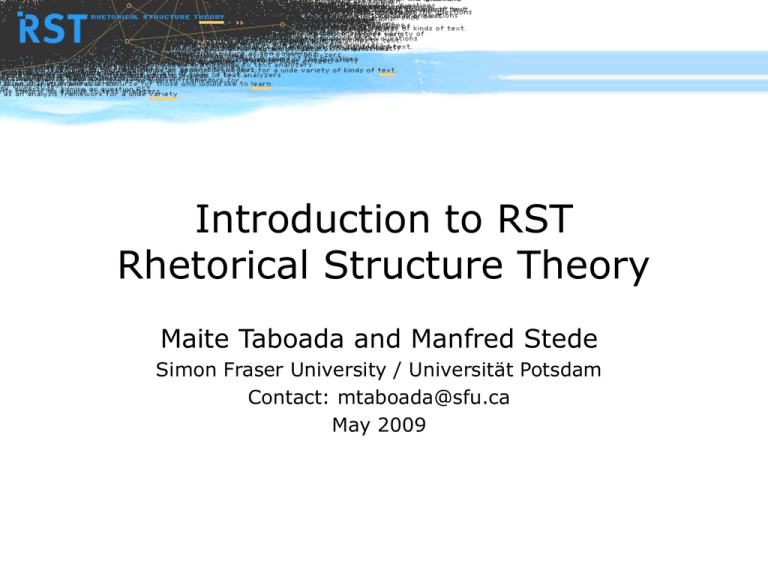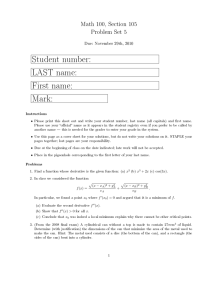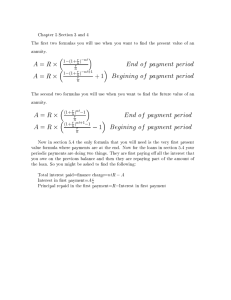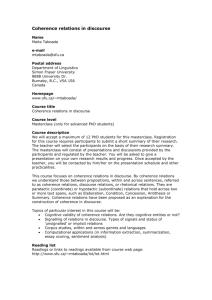Introduction to RST Rhetorical Structure Theory Maite Taboada and Manfred Stede
advertisement

Introduction to RST Rhetorical Structure Theory Maite Taboada and Manfred Stede Simon Fraser University / Universität Potsdam Contact: mtaboada@sfu.ca May 2009 Preface • The following is a set of slides from courses taught by Maite Taboada and Manfred Stede • It is distributed as a starting point for anyone who wants to present an introduction to RST • You are free to use and modify the slides, but we would appreciate an acknowledgement • For any comments and suggestions, please contact Maite Taboada: mtaboada@sfu.ca 2 Rhetorical Structure Theory • Created as part of a project on Natural Language Generation at the Information Sciences Institute (www.isi.edu) • Central publication Mann, William C. and Sandra A. Thompson. (1988). Rhetorical Structure Theory: Toward a functional theory of text organization. Text, 8 (3), 243-281. • Recent overview Taboada, Maite and William C. Mann. (2006). Rhetorical Structure Theory: Looking back and moving ahead. Discourse Studies, 8 (3), 423-459. • For many more publications and applications, visit the bibliography on the RST web site http://www.sfu.ca/rst/ http://www.sfu.ca/rst/05bibliographies/ 3 Principles • Coherent texts consist of minimal units, which are linked to each other, recursively, through rhetorical relations Rhetorical relations also known, in other theories, as coherence or discourse relations • Coherent texts do not show gaps or non-sequiturs Therefore, there must be some relation holding among the different parts of the text 4 Components • Units of discourse Texts can be segmented into minimal units, or spans • Nuclearity Some spans are more central to the text’s purpose (nuclei), whereas others are secondary (satellites) Based on hypotactic and paratactic relations in language • Relations among spans Spans are joined into discourse relations • Hierarchy/recursion Spans that are in a discourse relation may enter into new relations 5 Paratactic (coordinate) • At the sub-sentential level (traditional coordinated clauses) Peel oranges, and slice crosswise. • But also across sentences 1. Peel oranges, 2. and slice crosswise. 3. Arrange in a bowl 4. and sprinkle with rum and coconut. 5. Chill until ready to serve. 6 Hypotactic (subordinate) • Sub-sentential Concession relation • Concession across sentences Nucleus (spans 2-3) made up of two spans in an Antithesis relation 7 Relations • They hold between two non-overlapping text spans • Most of the relations hold between a nucleus and a satellite, although there are also multi-nuclear relations • A relation consists of: 1. 2. 3. 4. Constraints on the Nucleus, Constraints on the Satellite, Constraints on the combination of Nucleus and Satellite, The Effect. 8 Example: Evidence • Constraints on the Nucleus The reader may not believe N to a degree satisfactory to the writer • Constraints on the Satellite The reader believes S or will find it credible • Constraints on the combination of N+S The reader’s comprehending S increases their belief of N • Effect (the intention of the writer) The reader’s belief of N is increased • • Assuming a written text and readers and writers; extensions of RST to spoken language discussed later Definitions of most common relations are available from the RST web site (www.sfu.ca/rst) 9 Relation types • Relations are of different types Subject matter: they relate the content of the text spans • Cause, Purpose, Condition, Summary Presentational: more rhetorical in nature. They are meant to achieve some effect on the reader • Motivation, Antithesis, Background, Evidence 10 Other possible classifications • Relations that hold outside the text Condition, Cause, Result vs. those that are only internal to the text Summary, Elaboration • Relations frequently marked by a discourse marker Concession (although, however); Condition (if, in case) vs. relations that are rarely, or never, marked Background, Restatement, Interpretation • Preferred order of spans: nucleus before satellite Elaboration – usually first the nucleus (material being elaborated on) and then satellite (extra information) vs. satellite-nucleus Concession – usually the satellite (the although-type clause or span) before the nucleus 11 Relation names (in M&T 1988) Circumstance Solutionhood Elaboration Background Enablement and Motivation Enablement Motivation Evidence and Justify Evidence Justify Relations of Cause Volitional Cause Non-Volitional Cause Volitional Result Non-Volitional Result Purpose Antithesis and Concession Antithesis Concession Condition and Otherwise Condition Otherwise Interpretation and Evaluation Interpretation Evaluation Restatement and Summary Restatement Summary Other Relations Sequence Contrast Other classifications are possible, and longer and shorter lists have been proposed 12 Schemas • They specify how spans of text can co-occur, determining possible RST text structures circumstance motivation enablement joint contrast sequence sequence 13 Graphical representation • A horizontal line covers a span of text (possibly made up of further spans • A vertical line signals the nucleus or nuclei • A curve represents a relation, and the direction of the arrow, the direction of satellite towards nucleus 14 How to do an RST analysis 1. Divide the text into units • • 2. 3. 4. 5. 6. Unit size may vary, depending on the goals of the analysis Typically, units are clauses (but not complement clauses) Examine each unit, and its neighbours. Is there a clear relation holding between them? If yes, then mark that relation (e.g., Condition) If not, the unit might be at the boundary of a higher-level relation. Look at relations holding between larger units (spans) Continue until all the units in the text are accounted for Remember, marking a relation involves satisfying all 4 fields (especially the Effect). The Effect is the plausible intention that the text creator had. 15 Some issues • Problems in identifying relations Judgments are plausibility judgments. Two analysts might differ in their analyses • Definitions of units Vary from researcher to researcher, depending on the level of granularity needed • Relations inventory Many available Each researcher tends to create their own, but large ones tend to be unmanageable • A theory purely of intentions In contrast with Grosz and Sidner’s (1986), it does not relate structure of discourse to attentional state. On the other hand, it provides a much richer set of relations. 16 Applications • • • • • Writing research How are coherent texts created RST as a training tool to write effective texts Natural Language Generation Input: communicative goals and semantic representation Output: text Rhetorical/discourse parsing Rendering of a text in terms of rhetorical relations Using signals, mostly discourse markers Corpus analysis Annotation of text with discourse relations (Carlson et al. 2002) Application to spoken language (Taboada 2004, and references in Taboada and Mann 2006) Relationship to other discourse phenomena • Between nuclei and co-reference For more applications (up to 2005 or so): Taboada, Maite and William C. Mann. (2006). Applications of Rhetorical Structure Theory. Discourse Studies, 8 (4), 567-588. 17 Resources • RST web page www.sfu.ca/rst • RST tool (for drawing diagrams) http://www.wagsoft.com/RSTTool/ 18 Selected references (see RST web site for full bibliographies) • Carlson, Lynn, Daniel Marcu and Mary Ellen Okurowski. (2002). RST Discourse Treebank, LDC2002T07 [Corpus]. Philadelphia, PA: Linguistic Data Consortium. • Grosz, Barbara J. and Candace L. Sidner. (1986). Attention, intentions, and the structure of discourse. Computational Linguistics, 12 (3), 175-204. • Mann, William C. and Sandra A. Thompson. (1988). Rhetorical Structure Theory: Toward a functional theory of text organization. Text, 8 (3), 243-281. • Taboada, Maite. (2004). Building Coherence and Cohesion: TaskOriented Dialogue in English and Spanish. Amsterdam and Philadelphia: John Benjamins. • Taboada, Maite and William C. Mann. (2006a). Applications of Rhetorical Structure Theory. Discourse Studies, 8 (4), 567-588. • Taboada, Maite and William C. Mann. (2006b). Rhetorical Structure Theory: Looking back and moving ahead. Discourse Studies, 8 (3), 423-459. 19





